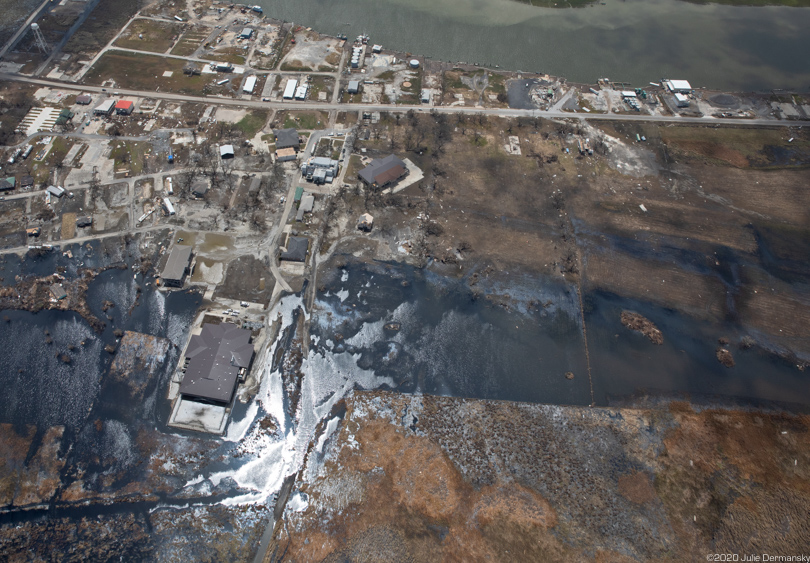In an effort to gain federal approval for a natural gas storage project in south Louisiana, Sempra LNG lobbyists crafted letters for Louisiana elected officials to send to federal regulators in support of the project.
Last fall, the Federal Energy Regulatory Commission (FERC) greenlit the Hackberry gas storage project, which involves converting underground domes constructed in the 1970s to mine for salt into storage space for up to 25.5 billion cubic feet of natural gas. Sempra LNG has been trying to build the project in Cameron Parish since 2006, when the company planned to store gas in the caverns from its liquefied natural gas (LNG) import facility. Horizontal drilling and hydraulic fracturing later created a surplus in U.S. natural gas, which is primarily composed of methane, a potent greenhouse gas.
The oil and gas industry searched for a market for the fossil fuel, using it as a main ingredient in synthetic fertilizers, amping up plastic production, and, beginning in 2016, exporting it overseas. In 2018, Sempra notified FERC that the company hadn’t gone through with the gas storage project because of unfavorable market conditions and requested to reapply for approval if market conditions improved. The company refiled in January 2021 as liquefied natural gas exports grew.

That same year Sempra lobbyists reached out to Louisiana Sen. Mike Reese and Rep. Les Farnum for help in the last few days of the federal public commenting period on the project. Coordination between Sempra lobbyists and the elected officials was discovered in emails obtained through record requests by Documented, an investigative watchdog group, and reviewed by DeSmog.
Despite Louisiana’s vulnerability to climate change and warnings from international scientists that new fossil fuel development must stop in order to avoid worsening climate disasters, elected officials in Louisiana have continued to use the weight of their offices to aid fossil fuel firms in developing projects in the state. In September of 2021, Jim Nickel — with the Baton Rouge-based lobbying firm Courson Nickel — emailed Rep. Farnum with a request. Sempra is among the companies that the lobbying firm actively represents, according to the Louisiana Ethics Administration Program.
“We are looking to get some comments in to the FERC in support of the Hackberry Storage Project,” Nickel wrote to Rep. Farnum on Friday, September 24, 2021. “They are due this Sunday – September 26. Sorry for the last minute request.”
Nickel added that he would provide a draft letter for Farnum to send to FERC. Gay Courson, also with Courson Nickel, sent a similar email to Sen. Mike Reese the same day. The next day the senator wrote back, “Below is evidence of my submittal,” with a digital receipt of submission from FERC. A year prior, the lobbying firm had donated $500 to Sen. Reese and $250 to Rep. Farnum, according to campaign contribution reports.
Naomi Yoder, a staff scientist with the environmental group Healthy Gulf, said it’s “short sighted” of lawmakers to submit letters written by a fossil fuel firm’s lobbyists in support of a project expected to emit the equivalent of nearly 200,000 metric tons of carbon dioxide per year. Healthy Gulf and Sierra Club have filed a request for a rehearing in the case. “We have a very disparate power system where lobbyists can get letters posted in support of a project from a lawmaker, which holds a lot of weight,” they said. “It’s not like the industry needs more seats at the table.”
FERC spokesperson Mary O’Driscoll did not share whether, or how, the agency might weigh comments from elected officials. “FERC fully reviews and takes into consideration all comments filed regarding proposed projects, and considers all the evidence presented before reaching its decisions,” O’Driscoll said in a statement.

Cameron Parish, where the project is being built, was struck by two hurricanes six weeks apart in 2020: Hurricane Laura and Hurricane Delta. The community was decimated and still has not recovered. These storms also damaged the area’s existing oil and gas tanks, pipes, and rigs, leaving oil sheens in floodwaters around homes and nearby wetlands.

Sen. Reese and Rep. Farnum did not respond to requests for comment, but public records show both lawmakers submitted letters of support for the project to FERC. “In an area that has been devastated over the past 12 months by two back-to-back hurricanes, flooding events and a winter freeze, we need responsible and respected companies like Sempra LNG to continue investing in our region,” reads the letter submitted by Sen. Reese on his official letterhead.
The letter also states that the company donated $500,000 towards Covid-19 and hurricane relief efforts. But Yoder pointed out that the company has also been granted huge tax breaks under the state’s Industrial Tax Exemption Program for its Cameron LNG export facility in Cameron Parish. Between 2003 to 2017, the company avoided paying $3.1 billion in property taxes, which would have gone to the local government and school districts.
Documented also found evidence in the metadata of a third letter of support, submitted by Cameron Parish Police Juror Curtis Fountain, that it too was drafted by Sempra lobbyists. (Police jurors hold the same role as county commissioners in other states.) Fountain did not deny the allegation, but directed questions to the company. “I submitted the letter because I support the project fully,” he wrote in an email.
Sempra LNG did not respond to questions about the company’s lobbying efforts. The company filed an extension to FERC in December 2022 to delay construction of the project until it finishes building its Port Arthur LNG export terminal near the Texas-Louisiana border. In total, FERC received 28 comments about the natural gas storage project during the public scoping period. Not all of the comments were in favor of the project.
Michael Tritico, a retired biologist who grew up less than 30 miles north of the proposed storage site, wrote several letters to the federal agency outlining his concerns about the project’s potential to cause a cavern collapse, which could release a huge amount of methane as well as lead to an oil leak from the Strategic Petroleum Reserve, the emergency crude oil stocks owned by the federal government and stored in salt caverns as close as 500 feet to the Sempra project.

Sempra plans to pump millions of gallons of water into underground caverns to dissolve the salt and hollow out the caverns for natural gas storage. The saltwater, or brine, created in the process would then be pumped out of the caverns and into four saltwater disposal wells. But Tritico pointed out that salt domes in south Louisiana have collapsed before. In 2012, the Bayou Corne salt dome collapsed, creating a sinkhole more than 300 feet across.
“Why risk a cavern collapse?” he asked. Tritico is also worried that Sempra’s plans to withdraw approximately 3.6 billion gallons of water from the Chicot aquifer over a period of about 27 months will draw down the drinking water for the town of Sulphur. “I’m just sick of them,” Tritico said of the elected officials who submitted letters to FERC drafted by Sempra in support of the project. “They’re intermediaries from here that make the carpetbaggers happy.”
Subscribe to our newsletter
Stay up to date with DeSmog news and alerts






